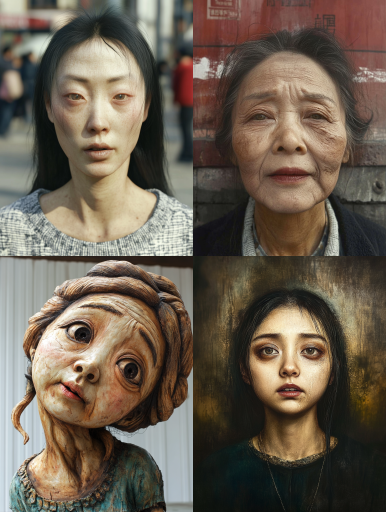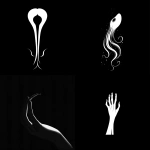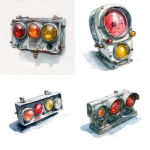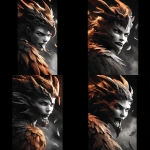Explore the Best AI Image Gallery

The Role of AI in Graphic Design: Transforming Creativity and Ethics
The graphic design landscape is rapidly evolving, and at the forefront of this transformation is artificial intelligence (AI). Although some might view AI as a mere tool for efficiency, its impact on the creative industry is profound, challenging traditional methods and pushing the boundaries of what is possible in design. In this post, we will explore the influence of AI on graphic design, its potential uses, the ethical considerations it presents, and future trends that are likely to shape this dynamic field.
The Evolution of Graphic Design with AI
Graphic design has always been a blend of creativity, technology, and communication. The integration of AI into this mix allows designers to leverage algorithms and machine learning to enhance their creativity and output. Tools powered by AI can analyze trends, automate repetitive tasks, and even generate design suggestions, thereby streamlining workflows and allowing designers to focus on more complex tasks.
For instance, platforms like Canva and Adobe Spark incorporate AI features that suggest layouts and color palettes based on user preferences or existing designs, which saves time and inspires creativity. In addition, AI can generate unique images from text prompts, like OpenAI's DALL-E, which allows designers to create visuals quickly without needing extensive graphic design skills.
Potential Uses of AI in Graphic Design
AI has several potential applications in graphic design that benefit both designers and clients:
- Automated Design Generation: AI tools can generate multiple design variations, enabling designers to explore different concepts without starting from scratch.
- Personalization: AI can analyze user data to create customized designs tailored to specific audiences, enhancing user engagement and satisfaction.
- Smart Editing: AI-powered editing tools can assist in photo editing, making processes like background removal or color correction quicker and more efficient.
- Predictive Analytics: Designers can use AI to analyze design trends, predicting what styles or concepts will resonate with audiences and keeping their work relevant.
Ethical Considerations
While the use of AI in graphic design offers numerous advantages, it also raises important ethical questions. As designers increasingly rely on AI, the implications for originality and ownership become significant. Who owns the design produced by an AI tool? Is it the programmer, the user, or the machine itself? This dilemma raises questions about copyright and intellectual property that the industry will need to address.
Moreover, the use of AI can lead to homogenization in design, with algorithms producing similar outputs based on existing patterns. This risk of diminishing uniqueness and creativity is a concern for many artists and designers who cherish originality. It is crucial for the creative community to engage in discussions about the balance between leveraging AI's capabilities and maintaining the integrity of individual artistry.
Future Trends in AI and Graphic Design
As technology continues to advance, the future of AI in graphic design looks promising yet challenging. One notable trend is the potential for collaborative design, where humans and AI work together as co-creators. This partnership allows designers to harness the power of AI while retaining their creative agency. Envision a scenario where designers create prompts that direct AI tools to iterate and refine designs, leading to innovative outcomes that neither could achieve alone.
Another trend is the growing emphasis on ethical AI, where developers aim to create tools that prioritize transparency and fairness. This includes ensuring algorithms do not perpetuate biases in design and that the creators of AI-generated artwork are properly credited. As conversations around ethical design gain traction, designers and developers will need to navigate these discussions carefully.
Conclusion
AI is undeniably transforming graphic design by enhancing creativity, improving efficiency, and sparking new ethical considerations. It pushes designers to rethink their processes and embrace technology as a partner rather than a competitor. The future holds exciting opportunities for those willing to adapt, innovate, and engage in the broader conversations surrounding ethics in the age of AI. As we move forward, it will be essential to find a balance that honors artistic integrity while exploring the vast potential that AI offers to the graphic design landscape.


](https://images.ai-img.art/thumbnails/150/8c320ce9aefbbb5b9ec5fd4e1d0fba7388f0fff5b6c2e2f14077cad3008f291d.webp)

](https://images.ai-img.art/thumbnails/150/3c5dc62bba83cc9919c20ebfec8430d31e821cef586a2753dd85ef26d77d480a.webp)

](https://images.ai-img.art/thumbnails/150/1d7b3a908141474d50d90721c394db29c0cb5404d685ae70ea60430c18e905b7.webp)



](https://images.ai-img.art/thumbnails/150/3e8c063b4357fc743a3c6e49a3145ee31b2dcecc018c38d2db8f97bf3e3fda3f.webp)












](https://images.ai-img.art/thumbnails/150/1accb5453f2335686b162f0a879c7ce73a18516a33868f214a16bdaf95beeb5a.webp)